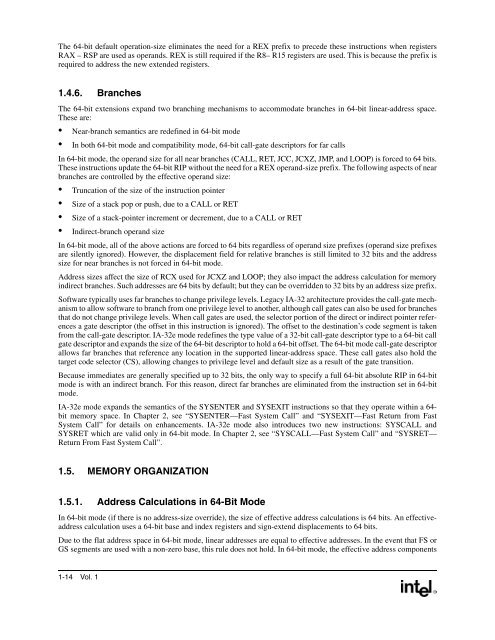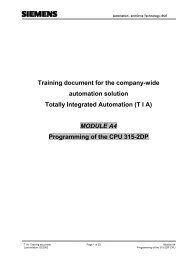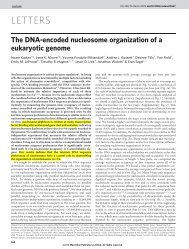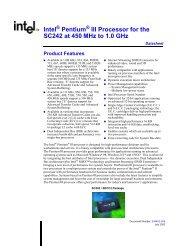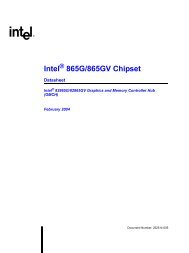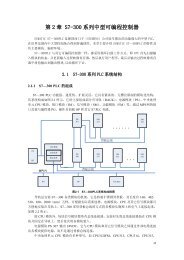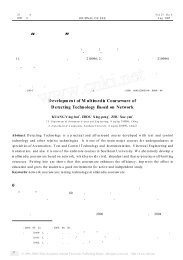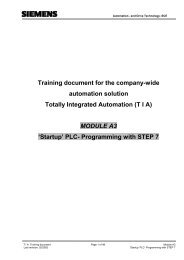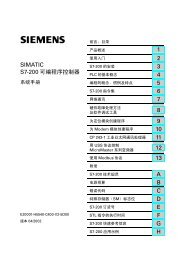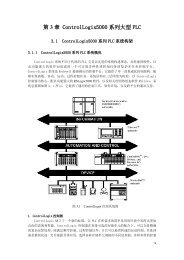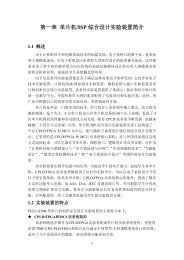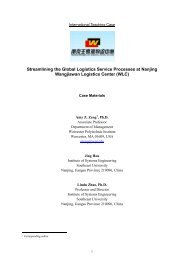Intel® Extended Memory 64 Technology Software Developer's Guide
Intel® Extended Memory 64 Technology Software Developer's Guide
Intel® Extended Memory 64 Technology Software Developer's Guide
You also want an ePaper? Increase the reach of your titles
YUMPU automatically turns print PDFs into web optimized ePapers that Google loves.
The <strong>64</strong>-bit default operation-size eliminates the need for a REX prefix to precede these instructions when registersRAX – RSP are used as operands. REX is still required if the R8– R15 registers are used. This is because the prefix isrequired to address the new extended registers.1.4.6. BranchesThe <strong>64</strong>-bit extensions expand two branching mechanisms to accommodate branches in <strong>64</strong>-bit linear-address space.These are:• Near-branch semantics are redefined in <strong>64</strong>-bit mode• In both <strong>64</strong>-bit mode and compatibility mode, <strong>64</strong>-bit call-gate descriptors for far callsIn <strong>64</strong>-bit mode, the operand size for all near branches (CALL, RET, JCC, JCXZ, JMP, and LOOP) is forced to <strong>64</strong> bits.These instructions update the <strong>64</strong>-bit RIP without the need for a REX operand-size prefix. The following aspects of nearbranches are controlled by the effective operand size:• Truncation of the size of the instruction pointer• Size of a stack pop or push, due to a CALL or RET• Size of a stack-pointer increment or decrement, due to a CALL or RET• Indirect-branch operand sizeIn <strong>64</strong>-bit mode, all of the above actions are forced to <strong>64</strong> bits regardless of operand size prefixes (operand size prefixesare silently ignored). However, the displacement field for relative branches is still limited to 32 bits and the addresssize for near branches is not forced in <strong>64</strong>-bit mode.Address sizes affect the size of RCX used for JCXZ and LOOP; they also impact the address calculation for memoryindirect branches. Such addresses are <strong>64</strong> bits by default; but they can be overridden to 32 bits by an address size prefix.<strong>Software</strong> typically uses far branches to change privilege levels. Legacy IA-32 architecture provides the call-gate mechanismto allow software to branch from one privilege level to another, although call gates can also be used for branchesthat do not change privilege levels. When call gates are used, the selector portion of the direct or indirect pointer referencesa gate descriptor (the offset in this instruction is ignored). The offset to the destination’s code segment is takenfrom the call-gate descriptor. IA-32e mode redefines the type value of a 32-bit call-gate descriptor type to a <strong>64</strong>-bit callgate descriptor and expands the size of the <strong>64</strong>-bit descriptor to hold a <strong>64</strong>-bit offset. The <strong>64</strong>-bit mode call-gate descriptorallows far branches that reference any location in the supported linear-address space. These call gates also hold thetarget code selector (CS), allowing changes to privilege level and default size as a result of the gate transition.Because immediates are generally specified up to 32 bits, the only way to specify a full <strong>64</strong>-bit absolute RIP in <strong>64</strong>-bitmode is with an indirect branch. For this reason, direct far branches are eliminated from the instruction set in <strong>64</strong>-bitmode.IA-32e mode expands the semantics of the SYSENTER and SYSEXIT instructions so that they operate within a <strong>64</strong>-bit memory space. In Chapter 2, see “SYSENTER—Fast System Call” and “SYSEXIT—Fast Return from FastSystem Call” for details on enhancements. IA-32e mode also introduces two new instructions: SYSCALL andSYSRET which are valid only in <strong>64</strong>-bit mode. In Chapter 2, see “SYSCALL—Fast System Call” and “SYSRET—Return From Fast System Call”.1.5. MEMORY ORGANIZATION1.5.1. Address Calculations in <strong>64</strong>-Bit ModeIn <strong>64</strong>-bit mode (if there is no address-size override), the size of effective address calculations is <strong>64</strong> bits. An effectiveaddresscalculation uses a <strong>64</strong>-bit base and index registers and sign-extend displacements to <strong>64</strong> bits.Due to the flat address space in <strong>64</strong>-bit mode, linear addresses are equal to effective addresses. In the event that FS orGS segments are used with a non-zero base, this rule does not hold. In <strong>64</strong>-bit mode, the effective address components1-14 Vol. 1


